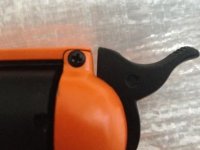If you are certain you have no ammo in the cylinder (sorry, even if it seems obvious, we are safety nuts in general!

) then try this.
--Open the cylinder all the way. We might help more on this if you posted pictures or could find model/brand info that we might search for images. Chances are, there is a round pin that goes through the middle of the cylinder that holds it in place and allows the cylinder to spin or "revolve" around it.
Typically, this pin would be drawn FORWARD and out of the gun, toward the muzzle end (toward the BAD GUY!) to open or remove the cylinder.
Remove this pin or pull it forward as far as you can.
--put the cylinder in place, properly, so that this pin can be pushed all the way BACK in place, towards the SHOOTER, so that the revolver is put completely back together and is functional. Sometimes, getting the pin to move this last little bit and CLICK in to place is difficult.
If it's not fully in place, it can/will keep the revolver from operating properly
--when you have the pin and cylinder in place properly, then put the revolver in your right hand and use your right thumb to draw the HAMMER rearward, while keeping your finger WELL clear of the trigger
When you pull it all the way, it should lock in place, cocked--and ready to fire
--now put your right thumb on the HAMMER and hold it in place while you PULL the trigger with your right index finger
Gently allow the hammer to come to rest, but keep your finger ON the trigger
While your finger continues to depress the trigger, observe that hammer
Is it FULLY to rest, where it would hit the blank? Sitting FLUSH, as you described in your post?
If NO, then try:
--with finger
still depressing trigger, attempt to lightly push further the hammer so that it DOES sit flush. It may go forward a bit, make contact, and rebound when you take pressure off the hammer. This is what
Mike Irwin alluded to in his post.
If that works, then the pistol is in fine working condition.
If it still will not go forward, I'd attempt to again cock the revolver, then pull that trigger as normal and see what happens. Keep your finger ON the trigger even after it has "snapped" or "fired" and observe where the hammer comes to rest now.
 Not sure what I might have done but is there anyway I can fix it? I have attached at photo showing the position the hammer is currently stuck in.
Not sure what I might have done but is there anyway I can fix it? I have attached at photo showing the position the hammer is currently stuck in.
